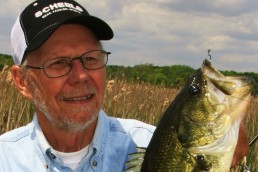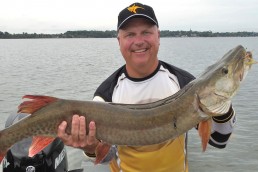Favorite Weedline Multi-species Baits for Summer
SHARE THIS POST
Anyone who fishes will tell you what their favorite lure is. Many will break it down to season, water depth, species, etc., and it then becomes apparent that we each have several. As a kid growing up watching Saturday morning fishing shows, I heard a quote that I still remember: “Our favorite lure is the one the fish are biting on that day.”
While this is likely true for most, we do have a go-to lure or two that we use more often because they’ve caught fish and we have confidence in them. Some are guilty of sticking with a favorite lure too long on days when it’s not the favorite for the fish. I’ve done this before. But I can experiment and get outside of my comfort zone so I’ve been able to discover some new “favorites.”
Summertime fishing on lakes means weeds. As the water warms and the weeds grow in moderately fertile to fertile lakes, prey species move to the weeds for cover. Many of these predators follow their prey into this cover. Depending on the species, some go deep into these weeds and stay there for months while others cruise the edges or alternate between these areas and the center of the weeds. They’re relating to the weeds because there’s food and cover.
Fishing weeds is tough, and this challenge deters some. But with the right equipment and techniques, you can find success.
Weeds on a flat and close to a drop-off to locations of deeper water are usually best, and wide expansive weed flats often hold more fish than the narrow strips of weeds. Weed beds with varying types are often good, and an area of cabbage or coontail mixed into a larger area of denser cover with milfoil will often be a fish magnet. Also target weeds next to an area of a hard bottom like rock or gravel.
I like to target the edges of weed beds including the insides early in July and then the outsides later. I’ll also check out points and pockets. These are where you’ll find a mix of weeds and hard-bottom areas to find multiple species. While largemouths often feed in these outer edges of weeds early and late in the day, if you move farther into the weeds during midday the walleyes and pike may be cruising near there all day. And if you can find that rock or gravel close by, this will likely hold the smallmouths and said walleyes. Try targeting these edges early and late in the day or on cloudy, windy days for maximum fish- feeding activity.
Are you enjoying this post?
You can be among the first to get the latest info on where to go, what to use and how to use it!
My first favorite lure for this type of fishing is the Rapala Rippin’ Rap. Water depth will determine size, though I like the size 6, and water and sky clarity will also determine color. My favorite is their Chartreuse Shad. This size and color combination just looks like a perch or a bluegill—favorite foods of predators in the weeds in summer. You can fish this bait with either spinning or casting tackle, but in either case you need a fast- or extra-fast-action rod with little tip bend to work the Rippin’ Rap effectively. A no-stretch line like Berkley FireLine or NanoFil is also necessary. Having the no-stretch quality makes it much easier to get the desired action, and a lure with abrasion resistance is a must in and around weeds.
During midday or other times when the fish are into the weeds more, you can cast baits like this out over the tops of the weeds and “buzz” it over them with a steady retrieve until you reach the edges. Then let the bait fall down the weed edge and finish it back to the boat with the ripping retrieve.
My second favorite for fishing weed edges is a swimbait. If I’m casting parallel to the edges and retrieving a swimbait back along those edges, I’ll use a 4- or 5-inch paddle-tail bait threaded on to a swimming jig head. The weight of the jig will be determined by water depth and retrieve speed. Colors will vary from day to day, but I usually start with something that looks like a perch or bluegill. If I need to get into the weeds more I’ll switch to a 3-inch paddle tail and fish it on a swimbait hook with an adjustable weight.
If the weeds are sparse or top out well below the surface, use a heavy-weighted hook and slide the weight forward for a straight retrieve with a few “flutters” in it. If weeds are thicker and closer to the surface, go with a lighter-weighted hook and position the weight near the bend of the hook. This allows me to “snap” and “dart” the baits over the weeds and back to the boat. In either situation, when casting over the weeds, drop the bait to the bottom when you clear the weed edge and then work the bait back up to the boat. Again, you can use spinning or casting tackle if you’re using a heavier weight. Otherwise, go to spinning tackle for lighter swimbaits. Again, a no-stretch, abrasion-resistant superline is effective in the weeds.
My last, but not least favorite, for species in and along weeds is a jig spinner. Growing up, I knew this as a Beetle Spin. But I put together my own jig spinners from components that included jig heads, soft plastics and jig-spinners of multiple sizes and colors. In and around weeds, I now use a jig head that has the line-tie at the nose of the jig that swims better through the weeds without getting hung up. Once again, you’ll have to adjust the weight of the jig head to the depth and thickness of the weeds. I like to start with perch/bluegill colors around the weeds, but don’t be afraid to experiment. I use grubs (curly tails), minnows (forked tails) and paddle tails with this setup. You can also use curly tails or grubs. The 3-inch plastics are what I start with, but I will go to 4 inches. Work these baits parallel to a weed edge or over and through the cover. I have probably caught the most in and around weeds in summer on this bait and definitely the most variety of species. I’ll also use spinning tackle for this bait with a superline like NanoFil.
I have “favorite” baits each for different situations. But for multi-species action in and around weeds, give these above a try. Don’t be afraid to experiment, and maybe you’ll discover some new favorites like I do almost every season.
MWO
SHARE THIS POST
Did you enjoy this post?
You can be among the first to get the latest info on where to go, what to use and how to use it!
Troy Smutka
Troy Smutka is a central Minnesota fishing guide (greatdayonthewater.com) and a walleye tournament angler. He is also a member of the Lund Boats, Mercury Outboards and Johnson Outdoors Pro Teams, and hosts and produces Fishing and Hunting the North Country on YouTube.



